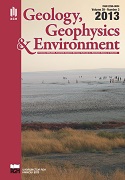POMIARY XRMI W UTWORACH CECHSZTYNU
DOI:
https://doi.org/10.7494/geol.2013.39.3.291Keywords:
microresistivity images, XRMI tool, beds, fractures, breakouts, evaporites, ZechsteinAbstract
Pomiar XRMI bazuje na kontraście mikroopornościowym skał. Sonda jest nazywana przyrządem „o rozszerzonym zakresie”, ponieważ daje bardzo dobrej jakości obraz ściany otworu, nawet w formacjach o wysokiej oporności (> 2000 ohm-m) i przy stosowaniu zasolonych płuczek o relatywnie niskich opornościach (< 0.1 ohm-m).
Dzięki dużej rozdzielczości pionowej pomiarów sonda ta daje możliwość interpretacji powierzchni warstwowania wraz z informacją o tym, w którym kierunku i pod jakim kątem są one nachylone oraz zidentyfikowania fałdów, uskoków i mikrouskoków, spękań, niezgodności kątowych. Na obrazach mikroopornościowych zaznaczają się również struktury powstałe w wyniku odwiercenia otworu: szczeliny indukowane, struktury wykruszeniowe typu breakouts, ślady świdra. Pomiary sondą XRMI mają wiele zastosowań w interpretacji strukturalnej i sedymentologicznej, mogą nieść również informacje o geomechanice górotworu, przydatne w procesach wiercenia otworu jak i zabiegów szczelinowania.
Abstract: XRMI measurement relies on microresistivity contrast of rock. It is called “X-tended R-ange M-icro I-maging” tool, because it gives a very good quality borehole wall images even in highly resistive formations (> 2000 ohm-m) and relatively low resistive salty muds (< 0.1 ohm-m).
Thanks to high vertical resolution of measurements this tool gives a possibility to interpret bedding surfaces with information about their dip angle and azimuth and to recognize folds, faults and microfaults, fractures, angular unconformities. On the images there can be seen structures, which appear as a result of drilling the well: induced fractures, breakouts, bit marks. XRMI measurements have application in both structural and sedimentological interpretation and can give some geomechanical information helpful in borehole drilling and hydraulic fracturing.
Downloads
References
Adams J., Bourke L. & Buck S., 1990, ”Integrating Formation MicroScanner Images and Cores”, Oilfield Review, Volume 2, No 1, 52 – 64.
Amer. A, Contreiras K., Cardoso E., Rueda M., Lopes A., 2009, “An integrated study to understand the effect of anhydrite on wells drilled near fault system in Pinda Formation, offshore Angola”, SPWLA 50th Annual Logging Symposium, 21 – 24 June 2009, The Woodlands, Texas, United States, 1-12.
Bielewicz D., 2009, “Płyny wiertnicze” Wydawnictwa AGH, Kraków, 1-451.
Chakravorty R., Gopala Rao V., Kumar R. & Roy S., 2009 “Extended Range Micro-Imager (XRMI)™ Applications in Coal Environment”, 2nd SPWLA - India Symposium, 19 – 20 November 2009, 1 – 22.
Dadlez R. & Jaroszewski W., 1994, „Tektonika”, Wydawnictwo Naukowe PWN, Warszawa, 1-743.
Jarzyna J., Bała M. & Zorski T., 1997, „Metody geofizyki otworowej: pomiary i interpretacja, Wydawnictwa AGH, Kraków, 1-252.
Kiełt M., 2002, „Geofizyka wiertnicza w poszukiwaniu węglowodorów” tom 1, Wydawnictwo Adam Marszałek, Toruń, 1 – 369.
Prensky S., 1992, “Borehole Breakouts and In-situ Rock Stress - A Review”, The Log Analyst, Volume 33, No 3, 304-312.
Downloads
Published
Issue
Section
License
Authors have full copyright and property rights to their work. Their copyrights to store the work, duplicate it in printing (as well as in the form of a digital CD recording), to make it available in the digital form, on the Internet and putting into circulation multiplied copies of the work worldwide are unlimited.
The content of the journal is freely available according to the Creative Commons License Attribution 4.0 International (CC BY 4.0)










